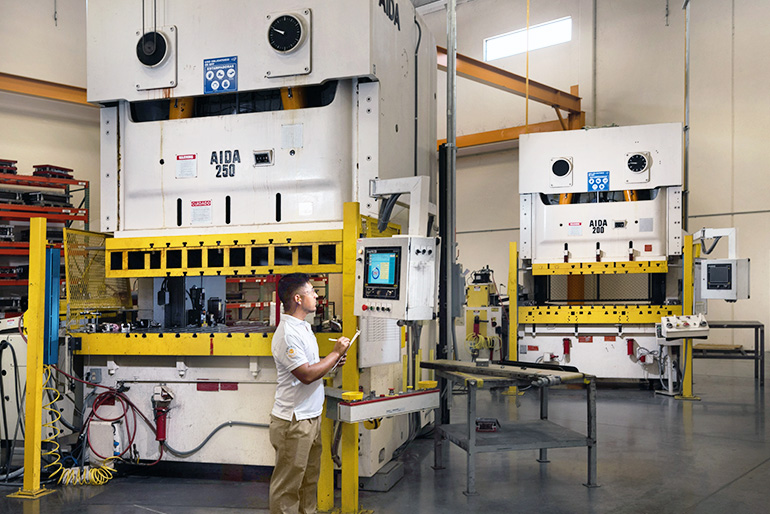Leading Metal Stamping Solutions for High-Quality and Cost-Effective Production
Leading Metal Stamping Solutions for High-Quality and Cost-Effective Production
Blog Article
The Advancement of Metal Marking Processes: Advancements and Applications
The realm of metal stamping processes has actually observed a transformative journey marked by continuous technology and adaptation to meet the needs of modern commercial methods. The applications span throughout a spectrum of industries, each profiting distinctly from the improvements in metal stamping procedures.
Standard Metal Marking Techniques
Typical steel marking techniques have actually long been the foundation of manufacturing procedures in numerous sectors as a result of their performance and precision. The process includes developing a steel sheet or coil right into a preferred shape by pressing it between a die and a punch. This technique is widely utilized for producing huge amounts of get rid of high precision at a rapid pace.
Among the essential advantages of conventional metal stamping techniques is the capacity to maintain limited tolerances, guaranteeing that each part fulfills the required specifications consistently. This level of precision is important in sectors such as automobile, aerospace, and electronics, where even small deviations can bring about considerable concerns.
Moreover, traditional steel stamping strategies provide economical options for mass manufacturing contrasted to various other manufacturing techniques. The capability to mark parts in fast sequence minimizes manufacturing time and reduces labor prices, making it an appealing choice for businesses seeking to optimize their production processes.
Appearance of High-Speed Stamping

Among the vital benefits of high-speed marking is its ability to keep accuracy and consistency even at accelerated handling speeds. This precision is important in industries where limited resistances and intricate styles are required. Additionally, high-speed marking enables the handling of a variety of products, including aluminum, stainless-steel, and copper, more broadening its applicability throughout various industries.
In addition, the development of high-speed marking has actually allowed makers to satisfy the growing need for complicated parts in markets such as vehicle, aerospace, and electronic devices (Metal Stamping). By leveraging the rate and accuracy of high-speed stamping modern technology, companies can boost their competitiveness in a quickly developing market landscape
Developments in Tooling Innovation
With the development of high-speed marking allowing improved accuracy and efficiency in metal developing processes, the area of steel marking has seen considerable improvements in tooling technology. Tooling innovation plays a vital duty in steel stamping procedures, influencing factors such as product top quality, production rate, and total cost-effectiveness. One crucial development in tooling technology is the advancement of smart tooling systems that include sensors and keeping an eye on tools to give real-time information on the marking procedure. These systems can discover concerns such as device wear or imbalance, permitting immediate changes to maintain optimal performance.
By making use of these advanced products, tooling manufacturers can generate dies and molds that stand up to the high pressures and temperature levels involved my review here in metal marking procedures, resulting in longer device life and better production efficiency. Generally, these advancements in tooling innovation have reinvented the steel marking sector, enabling producers to achieve greater degrees of accuracy, productivity, and expense savings.
Combination of Automation in Stamping
As automation continues to reshape the landscape of metal marking processes, the integration of automated systems has ended up dig this being progressively widespread in modern production centers. Automated systems offer various benefits in steel marking, including increased performance, improved precision, and enhanced security. By incorporating automation into stamping procedures, manufacturers can decrease cycle times, decrease material waste, and enhance manufacturing throughput.
One of the crucial components of automation in stamping is making use of robot arms for tasks such as material handling, part adjustment, and high quality inspection (Metal Stamping). These robotic systems can perform repeated and labor-intensive tasks with rate and accuracy, liberating human operators to concentrate on even more complex procedures. Furthermore, automation enables real-time monitoring and change of marking processes, resulting in greater total procedure control and quality control
Additionally, the integration of automation in stamping allows suppliers to attain regular part quality, meet limited tolerances, and improve total performance. As innovation continues to breakthrough, the function of automation in metal marking processes is expected to increase even more, driving technology and efficiency in the manufacturing industry.
Applications Throughout Diverse Industries
Including steel stamping procedures across varied markets showcases the flexibility and versatility of this manufacturing strategy. From automotive to aerospace, electronic devices to clinical tools, metal marking plays a critical duty in the manufacturing of a wide variety my website of parts. In the automobile industry, steel marking is used to develop elaborate parts such as body panels, framework parts, and engine get rid of high precision and effectiveness. The aerospace field counts on steel stamping for producing light-weight yet long lasting elements for aircraft and spacecraft. In the electronics industry, metal stamping is necessary for producing connectors, get in touches with, and various other small get rid of tight tolerances. Medical tool suppliers make use of metal marking for producing precise elements like surgical instruments and implants. Additionally, the appliance sector take advantage of steel marking processes to make components for refrigerators, cleaning makers, and other home devices. The flexibility of metal marking procedures makes it a useful production method across different markets, showing its importance in modern-day manufacturing procedures.
Conclusion

Report this page